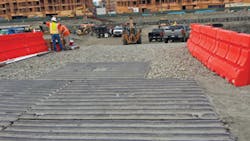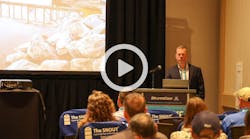One of the “hot buttons” for construction site inspectors is trackout of dirt, rock, and sediment from a work site. This matter was of special concern in Huntington Beach, CA, where a six-story apartment complex was being built on a highly visible 5-acre site in the city.
“They were having a bit of a trackout issue on the street, because the whole site was originally just a dirt pad,” explains Tony Decker, project manager with BMP Solutions, based in southern California. “We kept spreading rocks, and trucks were driving over the rocks, but this was getting maybe 50% of the mud and dirt that were on the tires.
“So we laid down nine trackout plates at the construction entrance, forcing trucks to drive over each set of plates before they went on out into the street. It was helping significantly. Then every couple days we had a worker who, at the end of the day, would sweep off the accumulated silt and debris on the plates. So there would regularly be clean, fresh trackout plates to drive over.”
Instead of debris entering the city streets and sewer systems, it remained onsite. The trackout plates were supplied by Contractors Services of Lakewood, CA. Some were rented by Decker’s BMP Solutions, while others were purchased outright.
“We’ve tried a couple different companies while we’ve been in business, but we prefer Contractors Services’ plates because they use thicker steel, they weigh more, and they’re just a heavier-duty, better quality product, in our opinion,” says Decker. “Some other plates use thinner steel or they’re lighter, and they tend to bend over time. They can crack and chip, and they’re not as good a product over time.
“We’ve had some plates on job sites for over a year. We have three plates of our own that we bought from Contractors Services. On one of our projects they’ve been in place for over a year and they haven’t bent or given us any problems. They’re still in great shape. All we do is use a laborer onsite every week or two to sweep them off, and they’re good as new.”
In addition to the trackout plates, other BMPs have also been employed on this project.
“Around the entire site, we put gravel bags as an erosion control device, so that when it rained, the water would run to the gravel bags. These gravel bags were then essentially filtering the water and allowing cleaner water to pass through, which would go into the street and enter the storm drain. We had protection on the storm drains as well, as a secondary erosion control device.”
Decker notes that at this point in the project, nasty weather isn’t of great concern. “It’s in a bowl. They’re below grade now. Everything has been maintained onsite. We have had some problems at another job site where they are building on a dirt pad. Two- and three-inch rain storms came, and they had quite a few inches of water on the site. It was almost like a giant lake. But here it hasn’t been an issue.”
Nor have there been environmental or habitat issues to speak of. Decker mentions, however, that on some other work sites that sit adjacent to a conservation area, the city and public works agencies have insisted on the use of trackout plates so that any potential runoff into the street doesn’t get thrown into the inlets and into the sensitive area.
The city inspectors that Decker has worked with frequently want to see trackout plates in place, and they visit sites regularly.
“I don’t know their exact schedule, but on most of the jobs we’re on, the city inspectors are out there about once a week or once every two weeks, and then also after each rainstorm. Pretty much all of the city inspectors require the use of trackout plates. They’re pretty happy when they see them out there. I’ve had a couple jobs just in the last couple months where a plan doesn’t show any plates but the city or the public parks inspector will require plates to be out there, because it’s an added erosion control measure.”
Typically, Decker says, “Once a site is paved, and there’s much less chance of any sediment leaving the site—that’s when they’ll remove the trackout plates. On this site, the dirt pad has now been replaced with pavement.
“Nevertheless, on this Huntington Beach job, which is a high profile project, they wanted to leave the trackout plates on the asphalt just as an added measure, to make sure no sediment was going into the street. This project is on the main city street, so there is a lot of exposure, a lot of eyes watching the job site.”
He adds that he doesn’t recall a job site where trackout plates damaged newly laid asphalt. “They sit flat, and as long as they’re sitting flat when you’re driving over them, it doesn’t damage it at all. I’ve never had a complaint about the plates on asphalt.”
Sometimes Decker will spray a soil binder to help seal vulnerable areas, minimizing the risk of erosion while work is in progress. This soil binder will typically remain on slopes until landscaping takes place, but it wasn’t necessary on this Huntington Beach project.
Once the city saw that the trackout plates were in place, inspectors’ concerns about sediment tracking out into the street were eased. “They realized the trackout plates were making a big difference,” says Decker. “We were initially having a sweeper out there once a week, but now the sweeper is out there maybe once a month.”


